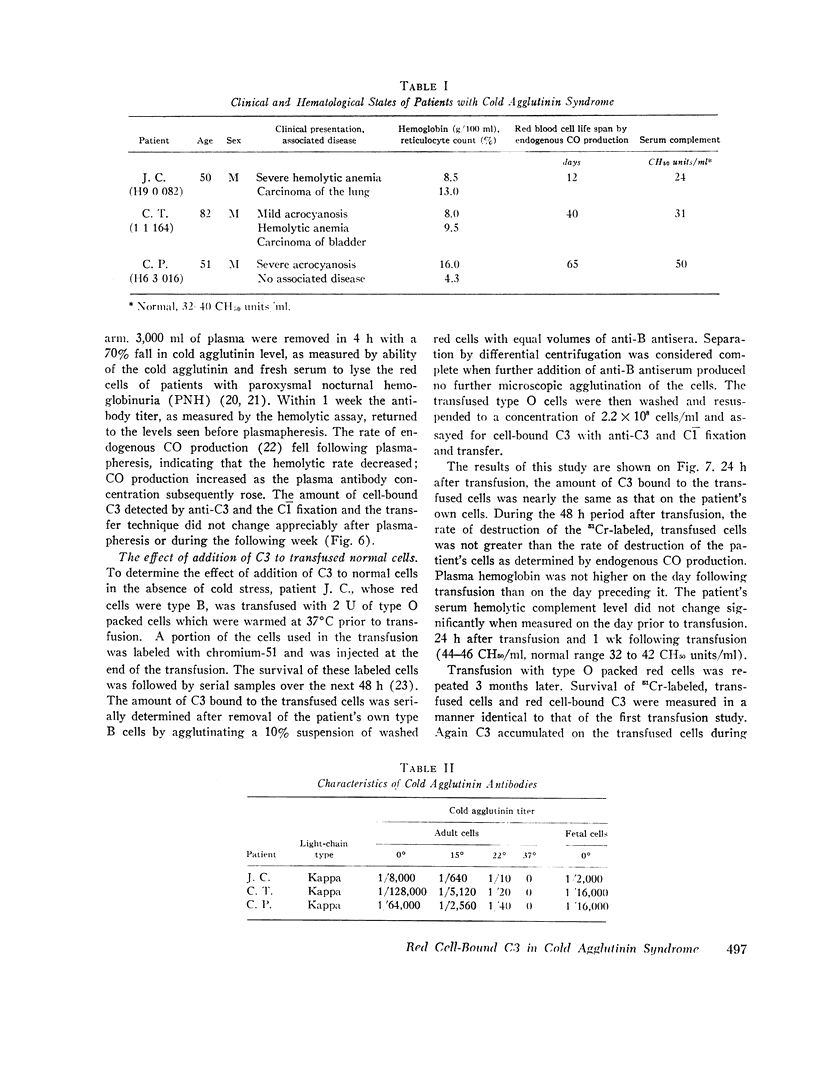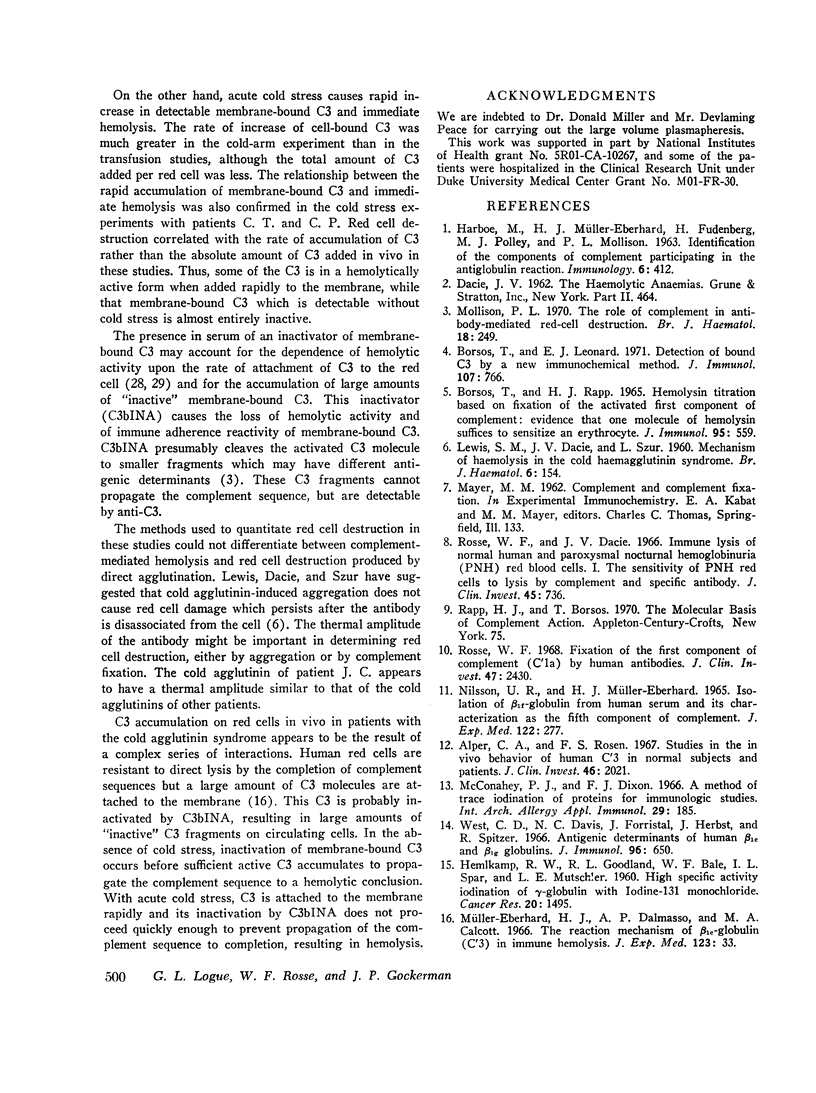Abstract
The amount of the third component of complement (C3) bound to red cells of patients with the cold agglutinin syndrome was determined by a quantitative assay, measuring the fixation of the first component of complement by anti-C3. Abrupt reduction in the serum concentration of cold agglutinin by plasmapheresis markedly decreased the hemolytic rate, but the amount of C3 bound to circulating cells did not change appreciably. When this patient was transfused with normal cells. C3 accumulated on the transfused cells within 48 h to the level present on his own cells, but selective destruction of the transfused cells did not occur. When patients were subjected to acute cold stress, cell-bound C3 rose abruptly and intravascular hemolysis occurred. These studies suggest that most of the C3 detected on the circulating red cells of cold agglutinin patients is in an inactive form, and that the rate of attachment of C3 to the membrane is important in determining hemolysis.
Full text
PDF








Selected References
These references are in PubMed. This may not be the complete list of references from this article.
- Alper C. A., Rosen F. S. Alper CA, Rosen FS: Studies of the in vivo behavior of human C'3 in normal subjects and patients. J Clin Invest. 1967 Dec;46(12):2021–2034. doi: 10.1172/JCI105691. [DOI] [PMC free article] [PubMed] [Google Scholar]
- BERLIN N. I., WALDMANN T. A., WEISSMAN S. M. Life span of red blood cell. Physiol Rev. 1959 Jul;39(3):577–616. doi: 10.1152/physrev.1959.39.3.577. [DOI] [PubMed] [Google Scholar]
- BORSOS T., RAPP H. J. CHROMATOGRAPHIC SEPARATION OF THE FIRST COMPONENT OF COMPLEMENT AND ITS ASSAY ON A MOLECULAR BASIS. J Immunol. 1963 Dec;91:851–858. [PubMed] [Google Scholar]
- Bernier G. M., Cebra J. J. Frequency distribution of alpha, gamma, kappa and lambda polypeptide chains in human lymphoid tissues. J Immunol. 1965 Aug;95(2):246–253. [PubMed] [Google Scholar]
- Borsos T., Leonard E. J. Detection of bound C3 by a new immunochemical methods. J Immunol. 1971 Sep;107(3):766–771. [PubMed] [Google Scholar]
- Borsos T., Rapp H. J. Hemolysin titration based on fixation of the activated first component of complement: evidence that one molecule of hemolysin suffices to sensitize an erythrocyte. J Immunol. 1965 Sep;95(3):559–566. [PubMed] [Google Scholar]
- Evans R. S., Turner E., Bingham M. Chronic hemolytic anemia due to cold agglutinins: the mechanism of resistance of red cells to C' hemolysis by cold agglutinins. J Clin Invest. 1967 Sep;46(9):1461–1474. doi: 10.1172/JCI105638. [DOI] [PMC free article] [PubMed] [Google Scholar]
- Evans R. S., Turner E., Bingham M., Woods R. Chronic hemolytic anemia due to cold agglutinins. II. The role of C' in red cell destruction. J Clin Invest. 1968 Apr;47(4):691–701. doi: 10.1172/JCI105764. [DOI] [PMC free article] [PubMed] [Google Scholar]
- HARBOE M., MUELLER-EBERHARD H. J., FUDENBERG H., POLLY M. J., MOLLISON P. L. IDENTIFICATION OF THE COMPONENTS OF COMPLEMENT PARTICIPATING IN THE ANTIGLOBULIN REACTION. Immunology. 1963 Jul;6:412–420. [PMC free article] [PubMed] [Google Scholar]
- HELMKAMP R. W., GOODLAND R. L., BALE W. F., SPAR I. L., MUTSCHLER L. E. High specific activity iodination of gamma-globulin with iodine-131 monochloride. Cancer Res. 1960 Nov;20:1495–1500. [PubMed] [Google Scholar]
- Logue G. L., Boyd A. E., 3rd, Rosse W. F. Chlorpropamide-induced immune hemolytic anemia. N Engl J Med. 1970 Oct 22;283(17):900–904. doi: 10.1056/NEJM197010222831704. [DOI] [PubMed] [Google Scholar]
- Logue G. L., Rosse W. F., Smith W. T., Saltzman H. A., Gutterman L. A. Endogenous carbon monoxide production measured by gas-phase analysis: an estimation of heme catabolic rate. J Lab Clin Med. 1971 May;77(5):867–876. [PubMed] [Google Scholar]
- McConahey P. J., Dixon F. J. A method of trace iodination of proteins for immunologic studies. Int Arch Allergy Appl Immunol. 1966;29(2):185–189. doi: 10.1159/000229699. [DOI] [PubMed] [Google Scholar]
- Mollison P. L. The effect of isoantibodies on red-cell survival. Ann N Y Acad Sci. 1970 Feb 13;169(1):199–216. doi: 10.1111/j.1749-6632.1970.tb55987.x. [DOI] [PubMed] [Google Scholar]
- Mollison P. L. The role of complement in antibody-mediated red-cell destruction. Br J Haematol. 1970 Mar;18(3):249–255. doi: 10.1111/j.1365-2141.1970.tb01440.x. [DOI] [PubMed] [Google Scholar]
- Müllerèberhard H. J., Dalmasso A. P., Calcott M. A. The reaction mechanism of beta-1C-globulin (C'3) in immune hemolysis. J Exp Med. 1966 Jan 1;123(1):33–54. doi: 10.1084/jem.123.1.33. [DOI] [PMC free article] [PubMed] [Google Scholar]
- NILSSON U. R., MUELLER-EBERHARD H. J. ISOLATION OF BETA IF-GLOBULIN FROM HUMAN SERUM AND ITS CHARACTERIZATION AS THE FIFTH COMPONENT OF COMPLEMENT. J Exp Med. 1965 Aug 1;122:277–298. doi: 10.1084/jem.122.2.277. [DOI] [PMC free article] [PubMed] [Google Scholar]
- Rosse W. F., Dacie J. V. Immune lysis of normal human and paroxysmal nocturnal hemoglobinuria (PNH) red blood cells. I. The sensitivity of PNH red cells to lysis by complement and specific antibody. J Clin Invest. 1966 May;45(5):736–748. doi: 10.1172/JCI105388. [DOI] [PMC free article] [PubMed] [Google Scholar]
- Rosse W. F., Dacie J. V. Immune lysis of normal human and paroxysmal nocturnal hemoglobinuria (PNH) red blood cells. II. The role of complement components in the increased sensitivity of PNH red cells to immune lysis. J Clin Invest. 1966 May;45(5):749–757. doi: 10.1172/JCI105389. [DOI] [PMC free article] [PubMed] [Google Scholar]
- Rosse W. F. Fixation of the first component of complement (C'la) by human antibodies. J Clin Invest. 1969 Nov;47(11):2430–2445. doi: 10.1172/JCI105926. [DOI] [PMC free article] [PubMed] [Google Scholar]
- Rosse W. F. Quantitative immunology of immune hemolytic anemia. I. The fixation of C1 by autoimmune antibody and heterologous anti-IgG antibody. J Clin Invest. 1971 Apr;50(4):727–733. doi: 10.1172/JCI106543. [DOI] [PMC free article] [PubMed] [Google Scholar]
- Ruddy S., Austen K. F. C3 inactivator of man. I. Hemolytic measurement by the inactivation of cell-bound C3. J Immunol. 1969 Mar;102(3):533–543. [PubMed] [Google Scholar]
- Ruddy S., Austen K. F. C3b inactivator of man. II. Fragments produced by C3b inactivator cleavage of cell-bound or fluid phase C3b. J Immunol. 1971 Sep;107(3):742–750. [PubMed] [Google Scholar]
- West C., Davis N. C., Forristal J., Herbst J., Spitzer R. Antigenic determinants of human beta-1c and beta-1g-globulins. J Immunol. 1966 Apr;96(4):650–658. [PubMed] [Google Scholar]


